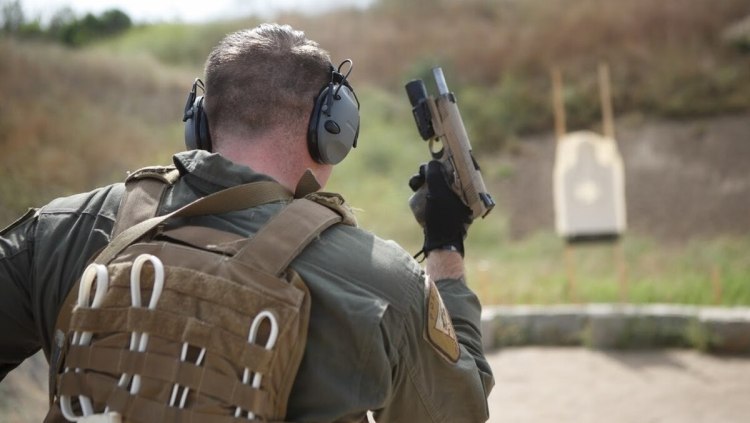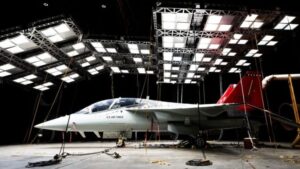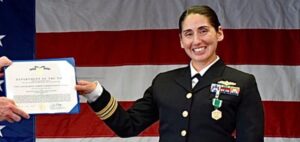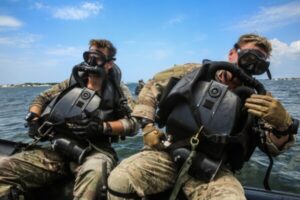I have said that a man in the Unit has free rein on the armament and combat kit that he carries. I must conclude that I don’t know if or how that applied to our secondary firearm, the Browning M-1911 .45 ACP (Colt) pistol. The fact is, NEVER in my 10-year tenure did I know of anyone or any situation in which a man decided he wanted to carry a different pistol than the venerable 1911. Dare I dismiss the notion by way of the function of “unwritten rule?”
I’ll tell you that it was widely acceptable to use a 1911 that was not a Colt build — such as Caspian — but to carry an M9 Beretta or a SIG Sauer… though they are weapons in the government inventory — was simply NOT seen in Delta. I’ll venture so far as to insist that a conversation of that topic never once fell on my ears.
I resign to the explanation that the 1911 is the matter-of-fact trademark of the Unit and its Operators. There is no argument that the 1911 is a comparatively difficult pistol to master, but the knockdown power is indisputable. The weapon’s reputation has -even been recognized by pipe-hitters in MARSOC where it was selected over the M9 Beretta as the Operator’s secondary combat arm.

My 1911s in Delta were tooled to match grade standards prior to their issue. I had elective modifications to my pistol such as a raised magazine and slide release buttons that were more conducive to operations while wearing our standard-issue Nomex Pilots flight gloves. I had an ambidextrous thumb safety and a beveled magazine well that lent itself well to quicker magazine changes. The trigger was no more than a two-pound pull.
Other modifications and Unit provisions are better left to nationally-renown gunsmith/M-1911 expert and former Delta Force Operator Larry Allen Vickers for a comprehensive explanation. Larry and I go back to the newly-formed 1st Special Forces Group (Airborne) where Larry, with his massive armament insight, assisted the new organization by serving temporarily as the Battalion Armor. We remain friends with a mutually respectful relationship to this day.

Dismiss what one may say about the weapon: it is an absolute hammer. Hammer was a nickname, along with “gat,” that some men used to refer to their sidearm M-1911. It occurred to me one day that a person actually could hammer nails with the gun and the gun would probably be alright in spite of it, though this author shuns the notion that you should vet that theory with your own pistol.

I can relay my own testament to the pistol’s brawn, having inadvertently subjected my 1911 to an impromptu drop test. My hammer took a lofty plunge as I summited the fifth floor of a five-story building during an urban combat mission. My primary (Winchester) went out of ammunition while firing on targets on the roof of the building. I attempted to transition to my secondary (M-1911) but drew only a handful of air, whereby my dry primary suddenly became a hickory Louisville Slugger that I cracked across the base of the neck of my target.
As the building became secure, I made a maddening dash to find and recover my gat. I found it lying on the concrete at the base of the building. The extent of the damage was a loosened ejector. The weapon still functioned just fine, though I had the armorer tighten up the ejector, as a broken ejector would result in an absolute and immediate malfunction the moment the ejector fell.
I have said that a man in the Unit has free rein on the armament and combat kit that he carries. I must conclude that I don’t know if or how that applied to our secondary firearm, the Browning M-1911 .45 ACP (Colt) pistol. The fact is, NEVER in my 10-year tenure did I know of anyone or any situation in which a man decided he wanted to carry a different pistol than the venerable 1911. Dare I dismiss the notion by way of the function of “unwritten rule?”
I’ll tell you that it was widely acceptable to use a 1911 that was not a Colt build — such as Caspian — but to carry an M9 Beretta or a SIG Sauer… though they are weapons in the government inventory — was simply NOT seen in Delta. I’ll venture so far as to insist that a conversation of that topic never once fell on my ears.
I resign to the explanation that the 1911 is the matter-of-fact trademark of the Unit and its Operators. There is no argument that the 1911 is a comparatively difficult pistol to master, but the knockdown power is indisputable. The weapon’s reputation has -even been recognized by pipe-hitters in MARSOC where it was selected over the M9 Beretta as the Operator’s secondary combat arm.

My 1911s in Delta were tooled to match grade standards prior to their issue. I had elective modifications to my pistol such as a raised magazine and slide release buttons that were more conducive to operations while wearing our standard-issue Nomex Pilots flight gloves. I had an ambidextrous thumb safety and a beveled magazine well that lent itself well to quicker magazine changes. The trigger was no more than a two-pound pull.
Other modifications and Unit provisions are better left to nationally-renown gunsmith/M-1911 expert and former Delta Force Operator Larry Allen Vickers for a comprehensive explanation. Larry and I go back to the newly-formed 1st Special Forces Group (Airborne) where Larry, with his massive armament insight, assisted the new organization by serving temporarily as the Battalion Armor. We remain friends with a mutually respectful relationship to this day.

Dismiss what one may say about the weapon: it is an absolute hammer. Hammer was a nickname, along with “gat,” that some men used to refer to their sidearm M-1911. It occurred to me one day that a person actually could hammer nails with the gun and the gun would probably be alright in spite of it, though this author shuns the notion that you should vet that theory with your own pistol.

I can relay my own testament to the pistol’s brawn, having inadvertently subjected my 1911 to an impromptu drop test. My hammer took a lofty plunge as I summited the fifth floor of a five-story building during an urban combat mission. My primary (Winchester) went out of ammunition while firing on targets on the roof of the building. I attempted to transition to my secondary (M-1911) but drew only a handful of air, whereby my dry primary suddenly became a hickory Louisville Slugger that I cracked across the base of the neck of my target.
As the building became secure, I made a maddening dash to find and recover my gat. I found it lying on the concrete at the base of the building. The extent of the damage was a loosened ejector. The weapon still functioned just fine, though I had the armorer tighten up the ejector, as a broken ejector would result in an absolute and immediate malfunction the moment the ejector fell.

The ejector should not be confused with the extractor. The extractor hooks the base of the brass cartridge casing and pulls it out of the chamber toward the rear of the carrier, where the ejector is. The extractor is a moving part that acts on the brass casing. The ejector is a static part that the brass casing acts upon to knock itself out of the upper receiver. Both the extractor and the ejector work in tandem in an active-passive role to rid the pistol of spent brass casings.

Yea, though I am put most squarely in mind of not one but two (at least?) 1911s that were inadvertently submitted to an impromptu drop test from a UH-60 Black Hawk helicopter on the very same air assault mission. It was our revered Alpha Sabre Squadron assault team that somehow lost control of two 1911s as the helo flared for landing. Both pistols were recovered with no damage other than to the egos of the involved by way of a commemorative cartoon from yours truly, the squadron cartoonist.

Ok, I must confess that, in fact, A-Team was fast-roping onto their objective with Simulations pistols that fire a paint slug but only come with conversion kits for 9mm pistols — no conversion kits for M-1911s. The team put their pistols in their 1911 holsters and grabbed the fast ropes at approximately 60 feet above the ground. The 1911 is a bigger and fatter pistol by profile, and the 9-mms were loose in the sloppy-fitting holsters. Several pistols fell out and made the plunge to the ground.
The running joke was that A-Team must have been stoned up there in the helicopter to have lost so many pistols in the same fashion. I was only a fur piece beyond deliriously happy to immortalize the team in the squadron cartoon annals. All the brothers of A-Team took their medicine with a chuckle at the cartoon for what it was worth — except the Grinch. The Grinch tried immediately to kill me with his bare hands. He was a very mean man.
For all things, there be a master: Many 1911’s failed to fire in the sandy atmosphere kicked up by Blackhawk helicopters during the Battle of the Black Sea in Mogadishu, Somalia October of 1993. The pistols were jammed so tight by the fine sand that the slides were frozen fast; the triggers and hammers would not so much as budge — they were of little more service than that masonry bricks.

I distinctly remember hearing an account where Delta’s CSM Thomas S. attempted to engage a Somali militia fighter who (thought) he was sneaking up on Tom’s fighting position. Tom took aim and pulled his trigger. The hammer dropped halfway and stuck. Tom immediately pulled the hammer back to the full-cocked position and pulled the trigger. Again the hammer stuck in the half-fall position. Tom holstered his pistol and hefted a frag grenade that obliterated the Somali fighter.
That was Maw-MAW Nature acting on the pistol, and she won.
For the part of the forces of man, the Unit armor in Mogadishu showed me the pistol of one of our own Delta men who was killed in the Battle: There was a hole the size of a pinky fingernail blown clean through it, such that you could see clearly through the hole. The hole was blown by the Rocket-Propelled Grenade (RPG) round that killed the brother.

The Browning M-1911 .45 ACP pistol is a true workhorse of a weapon with Delta. It is thought of as a status symbol by some — I think not, but perhaps to those whose minds just work that way. I, rather, define the 1911 as the best weapon selected by the Unit to accomplish a mission the way they see it being accomplished. Never mind the extra work and moxie it takes to harness the power of the weapon, the Unit deems it worth every effort.
I don’t even own a 1911 personally. I have found that the Banzai human wave attacks are far and fewer in the urban neighborhood I am currently settled in here in Albuquerque, New Mexico. For my personal protection, I carry the one and only pistol I have ever purchased — a Glock-17 that I acquired over 25 years ago. For the protection of my house, well… the hardware firepower principle is certainly there and the same, though the details depart vastly and grotesquely.

In the above photo is the author’s Glock-17 with rudely stippled handgrips for tenacious purchase, beveled mag well, weighted magazine butt caps, raised magazine and slide releases, and heavy-duty clip mounted to clip to trousers for concealed carry — no frills, tacticoolery, or tomfoolery — just practical functionality.
By Almighty God and with honor,geo sends



